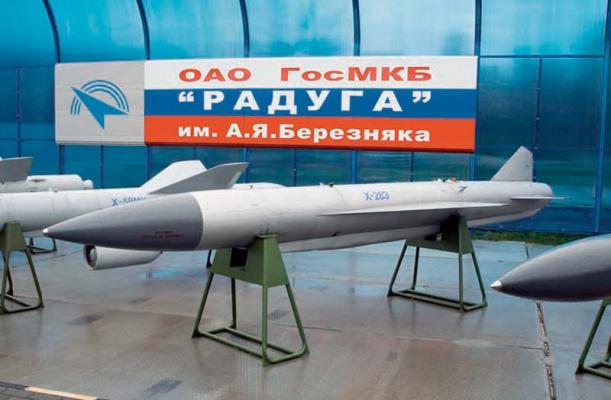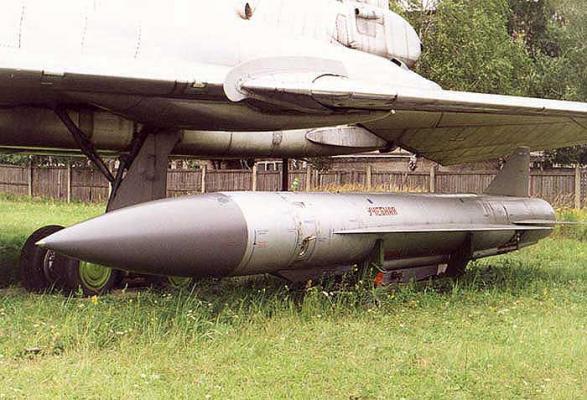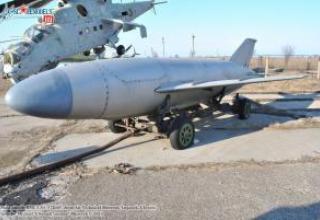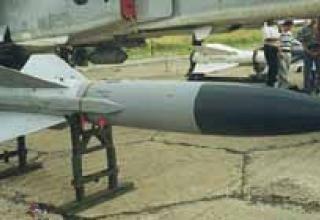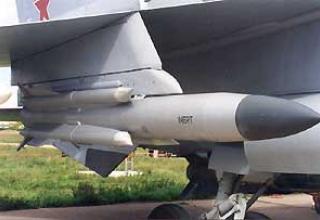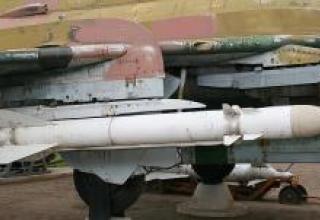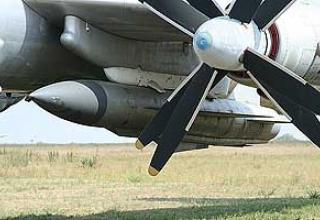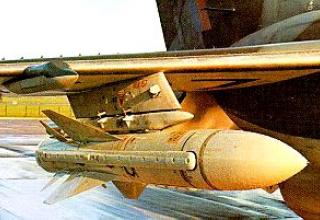The X-28 medium-range aviation anti-radar missile (article 93, D-8) is designed to fight ground and ship radars developed at the ICB "Rainbow" under the leadership of Chief Designer I.S.Seleznev under the decree of the USSR CM dated January 10, 1963.
X-28 was created using the design solutions of long-range missiles X-22 and SAC-5 and is a kind of a reduced copy.
The X-28 missile was to be part of the K-28P complex as part of the Yak-28N frontline fighter-bomber and two X-28 missiles. Tests of the Yak-28N carrier aircraft were launched in 1966, but it was not put into mass production. By the early 1970s, production of Yak-28 ceased, therefore, Su-17M and Su-24 fighter-bomber aircraft were used as X-28 carrier since 1973.
The Su-17M bomber-fighter, which had been under construction since 1972, could carry only one X-28 missile. The PU-28S launcher was suspended under the fuselage and a container with Metel-A equipment for reconnaissance of enemy radars and target designation issued to the missile's on-board equipment was mounted on a pylon under a fixed wing part.
In 1976, testing was completed on the Su-24, which could carry two X-28 missiles. The Su-24 was equipped with the target and target designation station "Owlin". The Su-17M fighter-bomber was a single-seat bomber, while the Su-24, apart from the pilot, had a navigator capable of better evaluating the situation and making decisions on the use of missiles. In addition to these aircraft, the carrier of the X-28 was MiG-23B.
At present, the X-28 is out of service with the Russian Air Forces. It was replaced by X-58, X-25MP, X-31P missiles.
X-28 missile was exported to foreign countries, was in service with the Air Force of Yugoslavia, Libya, Iraq and the countries - members of the Warsaw Pact. It was used in combat operations of the Iraqi Air Force called Nissan-28 (see photo) in the Iran-Iraq war.
In the west, the missile was designated AS-9 "Kyle".
Composition:
The X-28 missile (see projections, layout diagram) is arranged according to the normal aerodynamic scheme. The casing is cylindrical, variable in length and diameter. The nose section has an ogival shape CNS fairing. Fenders trapezoidal in terms of shape, with straight rear and arrow-shaped front edges (arrow-shaped angle of 75 °).
The steering surfaces are one-piece rotatable, the horizontal surfaces repeat the shape of the wing. The vertical plumage consists of two parts - the upper all-terrain steering surface and the lower foldable, uncontrollable. The steering wheel drive is electrohydraulic EGS-40L. Power was supplied from mono ampoule battery A-221 through converter PTO-300/500K.
The X-28 was powered by the R-253-300 liquid-propellant two-chamber jet engine developed at the Design Bureau-300 under the leadership of S.K.Tumansky.
The guidance system is a passive radar homing head of the PRG-28M type. SST is developed in the Central Design Bureau-111 (NPO "Automatics" Omsk, Kirchuk A.S.). The missile can be equipped with three types of passive radar SOS for pointing at ground and ship radars operating in three main frequency ranges. Autopilot - APR-28 was developed at the Research Institute-923 (Chief Designer Antipov E.F.).
The kinetic heating in flight with high speeds (up to M = 3) made the lining made of heat-resistant press material be installed on the front edges of the wing and plumage. The construction itself was mainly made of heat-resistant materials - ZOHGSA, EI-65I and special dural D19 steels. 1250x300 mm volumetric bow fairing was made of glass fibreglass using special technologies combining high radio transparency with required strength and heat resistance. Nevertheless, to ensure the specified performance, the first series X-28 had to be equipped with three different cones designed for a certain range of waves. Later it was possible to achieve "clearing" of fairings and required radio-transparency in all required frequency spectrum.
The 9A283 high-explosive combat unit weighing 155 kg carried 74 kg of explosives and was equipped with a contact electromechanical fuse of the computer-139 and a non-contact fuse of the ROV-5, which ensures the detonation of the BC in the air at an altitude optimal for radar destruction. The combat unit was mounted in the body from the end, the fuel and oxidizer tanks had no inter-tank compartment and were made according to the combined scheme. Feature of the missile was the possibility of installing a removable BC, including nuclear (X-28 was to "hack" the enemy's air defense, clearing the way for groups of strike aircraft).
Pipelines for fuel components and pneumatic system fittings were laid in a box (garglotte). The garglot also contained an autopilot's angular velocity sensor installed approximately in the middle of the missile's length, which minimized the influence of bending vibrations on the measured angular deflections of the missile. Behind the tanks-bays were placed the interface elements with the carrier systems and electromechanical converter PTO-300/500K, behind them - the main unit of the autopilot APR-28 and mono ampoule battery A-221. The tail part of the rocket was occupied by elements of electrohydraulic drive EGS-40L and liquid rocket engine R-253-300.
Carriers of the X-28 were Su-24 and Su-17M (M2, MZ), and the large size of the X-28 required an original modification of the Su-17: in the place of the basement suspension of the missile had to install a panel with a stamped under its keel, and the bottom keel folded like "big" missiles X-22 and KSR-5. The very suspension of the plane launch PU-28S was not an easy thing - its beam weighed 100 kg.
The rocket system's support and control equipment was housed on the Su-17 in a suspended container (the Metel-A and Metel-AB systems, differing in range), while the Su-24 was on board the aircraft (the Filin-N system). With their help, the SOS and SAU were preparing the missiles for launch, obtaining information about the direction on the radar, bearing and pitch angles, and programming the flight and target exit profile. Receiving antenna when using the "Blizzard" served as the GSN of the missile, "Owl" itself was a passive RAF with equipment and antennas that served to detect and direction finding the target with subsequent data entry into the missile system. The autonomous search and defeat by the Blizzard proved to be too difficult. Aiming at the X-28 could be carried out only on the radar target, the position of which has already been established, and the pilot's task was to go into the intended launch zone, tie to the landmarks and after the capture of the object GSN launch.
Significant mass characteristics of the X-28, in the end, were the result of its requirements and the level of equipment of that time: the circular probable deviation reached 20 m, which required a powerful BC for a reliable defeat and without direct hit. The LCD with a starting thrust of more than 8000 kgf, which provided high speed and range (in operation, in terms of speed and starting height, it was limited to 30 - 35 km, although at high altitudes it could be much more) brought a lot of operational difficulties. To store the rocket, equipped with 235 kg of "soaring" oxidizer AK-27P (a mixture of nitric acid and nitrous oxide) and not less caustic and toxic fuel TG-02, it was impossible for a long time, and after draining the tank needed to be thoroughly washed with neutralizing solution and dried, which required special means, strength and time, and hardly provided even on stationary airfields, not to mention field conditions. A set of equipment and test equipment was deployed at special sites for the preparation of missiles PPR-28, and all work was performed in protective suits.
Characteristics:
| Length, mm | 5970 (6040) |
| Maximum fuselage diameter, mm | 430 |
| Wingspan, mm | 1930 |
| Missile launch weight, kg | 690 (715) |
| Weight of the blast combat unit 9A283,kg | 140 |
| Range of fire, km - on the project basis - from a height of 5 km - low |
90-110 (120) 70 25-45 |
| Flight Speed, m/s | 800 |
| Height of application, m | 200-11000 |
| Circular probable deviation, m | 20 |
| Opportunity of hitting the target | 0.8 |
Testing:
The X-22 missile proved to be a very effective anti-ship vehicle even without a nuclear charge. Tests have shown that in the event of a sea target being hit, the X-22 would cause damage to the target ship, which could disable an aircraft carrier or cruiser. At the take-off speed of 800 m/s, the area of the hole was up to 22 sq.m., and the inner compartments were burned by a cumulative jet to a depth of 12m.
The Soviet leadership considered the aircraft Tu-95K-22 and Tu-22M3 with the X-22 rocket the most effective tool to combat aircraft carriers. Therefore, Soviet heavy aircraft systematically approached the U.S. aircraft carriers and recorded the action of radio electronic interference Americans. According to navigators, the effectiveness of these tools was tremendous: the target markings on the screens literally drowned in a cloud of interference, it became impossible to aim. Therefore, a version of the attack was developed, according to which the first to launch X-22 missiles with nuclear warheads are not on specific targets, and the area where the American aircraft carrier connection was to be. It was believed that after that the action of electronic countermeasures will significantly reduce, and the second wave of X-22 missiles will find surviving targets.
Measures to overcome the air defense included a variety of tactical techniques: massaging efforts of several strike groups, echelonizing the combat orders of missile carriers and air defense aircraft that covered them, maneuvering during an attack. The strike could be delivered by reshaping several units and launching from different directions, frontal attack with salvo launch of dozens of missiles, consecutive disabling of cover ships, weakening of the air defense and defeating the main target. Sometimes a distraction group of aircraft stood out. During combat training, the targets were real AUGs, which were within the reach of missile-borne units. The appearance of potential enemy ship groups near the Soviet shores usually served as an excuse to work out a plan of counteraction with training anxiety and regimental flight. During daily training, crews were limited to tactical launches.
Until the beginning of the 90s, the crews of both YES and Navy conducted combat firing at sea targets in the Caspian Sea, for which the crews from remote airfields moved closer to the firing range during training sessions. Mozdok usually served as a base for "long-range" airfields, and Oktyabrskoye in Crimea served as a base for "sailors". Over time, the range in the Caspian Sea, which had been in operation since the 50s, was closed by environmentalists' demands due to the contamination of the sea with countless missile debris. Problems have also arisen with the organization of shooting at the Akhtuba range, which is now under Kazakhstan's control.
With the removal of weapons Tu-22K and Tu-95K-22 missile system K-22M continued to remain in service, using the aircraft Tu-22M3 - the most modern machines of this type. Equipped with these parts are the basis of the missile forces of the YES and the Navy in Russia and the Ukraine. By 1994, there were 92 aircraft of this type in Ukraine and the Crimea.
In April 1987, the forces of the Russian YES were consolidated into the 37th FA of the Navy. To date, the Tu-22M3 are in service with four of its air regiments, as well as two maritime missile-bearing regiments on the SF and TOF (in the early 80's at the height of Soviet aviation fleet had a fleet of one and a half dozen missile-carrying regiments).
After several years of uncertainty, rocket firing at newly equipped firing ranges also resumed (their arrangement was linked not only to the choice of small, extensive locations for safety requirements in case of missiles or irregular missile behavior, which sometimes happened, but also to the equipment of measuring posts and telemetry control points). For the first time, the Tu-22M3 of the Severomorsk Kirkenes Red Banner Air Division carried out missile launches in the Barents Sea during the Zapad-99 command and staff exercise in northern Russia. Striking together with the missile ships of the fleet, 24-26 June 1999 TU-22M3 "destroyed" detachment cover enemy ships at a range of 100 km, and the "main target" - with 300 km. In September the same year, the TU-22M3 detachment conducted missile firing at targets four X-22.
During a joint exercise of the Air Force of Russia and Ukraine August 11, 2000 a pair of Poltava Tu-22M3 made a five-hour flight to the North and together with 10 Russian aircraft attacked targets at the testing ground near Novaya Zemlya. Although only three pilots had participated in the launches before due to the long break, both target barges were hit.
Two weeks later, on 25th August 2000, the crew of the Ukrainian Tu-22M3 performed an unusual task: providing joint exercises of the Air Forces and Air Defence at the Arkhalyk range, after a long flight it fired an X-22 target missile successfully intercepted and hit by Su-27 fighters.
On 6 April 2001, during a major exercise of the 37th Air Force combined with the Yuzhny Shield-2001 KShU, the X-22 was launched, which was of research nature: a missile that had been stored in a warehouse for 25 years was taken to check reliability. Launch from the board of the Tu-22M3 at the Makat test site was a success, all systems of the X-22 worked off routinely. Less successful were the shooting at the new range near Chita in September 2002 - due to failure in the guidance missile fell in Mongolia, causing a scandal and demands for millions of compensation (the same slippage took place in Kazakhstan, where the X-22 fell near the village).
The X-22 took an exceptional place in domestic aviation and rocket technology - both in terms of the service life of the complex, approaching the 40-year mark, and the universality of application. Unlike other missiles of its class, whose service was limited to a single type of aircraft (in turn, a special modification of which was created for a certain complex of missile weapons). X-22 was armed with three carrier aircraft - Tu-22K, Tu-22M and Tu-95K-22.
However, the long service and improvement of the complex could not save it from a significant disadvantage - low serviceability associated with the use of liquid rockets. The high performance achieved by the use of liquid-propellant missiles, brought with it organic flaws and problems with ensuring the combat readiness of missiles, which required equipment with toxic and caustic components - acid and no less harmful fuel.
Prolonged storage in refueled form proved to be unacceptable due to corrosion resistance of the structure. The use of protective coatings and inhibitors - corrosion retardants - also prevented this threat from being radically eliminated. At one time, the solution was to organize a continuous cycle of work on missiles, in which at the expiration of the period of maintenance of fuel and oxidizer refueled AKR from them, removed BC, the tanks were washed with neutralizing solution, dried, and the missiles were put in storage, while the next stage of the AKR after the equipment was ready for combat duty. The labor-intensiveness of such a "carousel" with maintenance of constant combat readiness created too many obstacles; and the main direction was to improve the refueling technology, which accelerated the process as much as possible and simplified it with due security.
The most effective measure was the introduction of ampoule filling with a special unit. The oxidizer from its sealed pressure vessels was pumped into the rocket tanks, remaining virtually isolated from the environment. Filling was carried out just before firing, and storage of the missiles was no longer permitted. The equipment of the rocket technicians included a protective special suit with a woolen suit to be worn under it, thick rubber gloves on top of ordinary knitted ones, and bashila boots in a thick finger. The equipment was equipped with an insulating gas mask, and the filling process was controlled by a gas analyzer in case of leakage. Labor-intensive operations in combat units were avoided as much as possible, and flights with unpacked missiles became a common practice even at the exercises. In full, their training was carried out only when offsets launches were carried out, at best, during training sessions 1-2 times a year. Shooting was an event, and in practice, given the responsibility, only the most trained crews with similar experience were allowed to fly. The training usually took at least one month, with several rehearsals. The launch always took a couple in which a substitute crew provided backup in case of refusal. Sometimes volley launches were made by a pair of missiles or both crews, including X-22 of different types with radar and inertial guidance.
Sources:
- А.В.Карпенко, С.М.Ганин "Отечественные авиационные тактические ракеты" - СПб,"Бастион", 1.2000
- Х-28 (изделие 93 или Д8, AS-9 «Kyle»)
- В. Марковский, К. Перов "Советские авиационные ракеты "Воздух-земля".М., Издательский центр «Экспринт»
